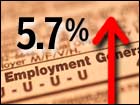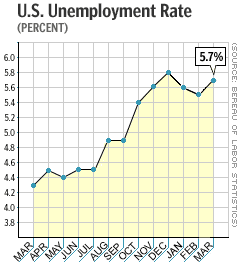
NEW YORK (CNN/Money) -
The U.S. unemployment rate rose to 5.7 percent in March, the government said Friday, as the labor market struggled to recover from a recession that led to more than a million job cuts in 2001.
The unemployment rate was 5.5 percent in February. Employers added 58,000 jobs to payrolls in March, compared with a revised loss of 2,000 jobs in February, the Labor Department reported. Economists had forecast an unemployment rate of 5.6 percent and 50,000 new jobs, according to Briefing.com.
"Although today's employment report provides little evidence of anything resembling a double-dip recovery, it does provide stronger support for the onset of a gradual to a moderate recovery in the months ahead," said Anthony Chan, chief economist at Banc One Investment Advisors.
The report helped lift U.S. stock prices in early trading, though they ended mixed on the day. Treasury bond prices rose.
The Labor Department pointed out that the jobless rate has been within two-tenths of a percentage point of 5.6 percent since October 2001. It's a lagging indicator, meaning it will likely continue to rise even as the economy recovers because employers are reluctant to add new jobs until they're sure a recovery is under way.

Though it seems inconsistent that the unemployment rate could rise even as the economy added jobs, Labor Department officials pointed out that the two numbers are actually generated by separate surveys -- the unemployment rate comes from a survey of households, while the payrolls data come from a survey of businesses.
Also, the payrolls data are subject to revision. For example, the government's initial reading of nonfarm payroll growth in February found 66,000 new jobs, but the number was revised to a loss of 2,000 jobs this month. A gain of 58,000, in other words, is not statistically significant.
Though the labor force -- the number of workers either employed or unemployed and looking for work -- shrank a bit in March, it's likely to rise this year as workers, encouraged by good news about the economy, resume their job hunts.
"We're still several months away from job growth catching up with labor force growth and driving the unemployment rate back down, but that's really just a matter of time," said Bill Cheney, chief economist at John Hancock Financial Services. "Our economy is moving again, and once that happens it's actually quite hard to stop the forward momentum."
To keep consumers spending despite rising unemployment and a recession that likely began in March 2001, the Federal Reserve cut its target for short-term interest rates 11 times in 2001. But the central bank left rates alone at its first two meetings of 2002, and Chairman Alan Greenspan has declared the recession over.
Some Fed watchers think policy makers will move quickly to raise interest rates and fight inflation, but recent reports showing sluggishness in the labor market and the manufacturing sector, combined with rising oil prices -- which could hurt consumer and business spending -- suggest the economy's recovery could be sluggish, allowing the Fed to leave rates lower for a longer time.
"For markets that have recently priced in 'nearly immediate' Fed tightening, [Friday's] data suggest more breathing room, even as tightening is likely to take place when recovery is more deeply entrenched," said Citigroup economist Steven Wieting.
Encouragingly, the service sector, which is by far the nation's largest employer, added 118,000 new jobs in March, the biggest gain since September 2000.
| |
 Related links
Related links
| |
| | |
| | |
|
The manufacturing sector lost 38,000 jobs, but that's the lightest loss since December 2000 and a smashing success compared to average monthly job losses of 111,000 between January 2001 and January 2002.
The average work week for all industries was steady at 34.2 hours. But the length of the manufacturing work week rose to 41.1 hours, the highest rate since November 2000, while overtime manufacturing hours rose to 4.2.
"Typically, when you get lengthening of the work week, hirings follow," said Joseph LaVorgna, senior economist at Deutsche Bank Securities. "First you work your employees harder, then you realize you can't work them too hard and you have to start hiring. This is a good sign for the facory sector going forward."
Average hourly earnings rose by 4 cents in March to $14.67, a gain of 0.3 percent.
Economists pointed out that, with companies increasing output without greatly increasing wages, corporate productivity and profits would benefit, possibly helping to fuel business spending later in the year. Greenspan and other economists think business spending will be key to the broader economic recovery; after all, a slowdown in corporate spending brought on the recession in the first place.
"We saw companies push up output strongly without increasing labor costs at all," said David Kelly, economist at Putnam Investments. "As orders come in, they will have to increase their total employment. Unless economic growth slows very rapidly, the unemployment rate should begin to move down in the next few months."

|

